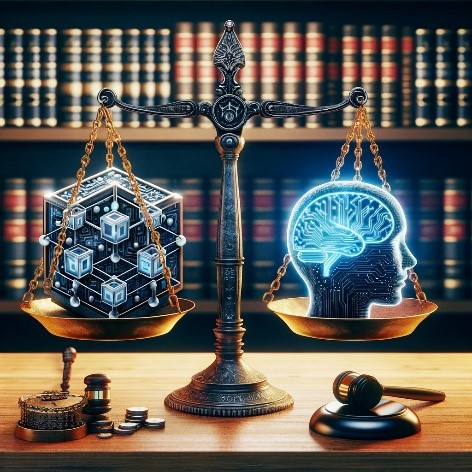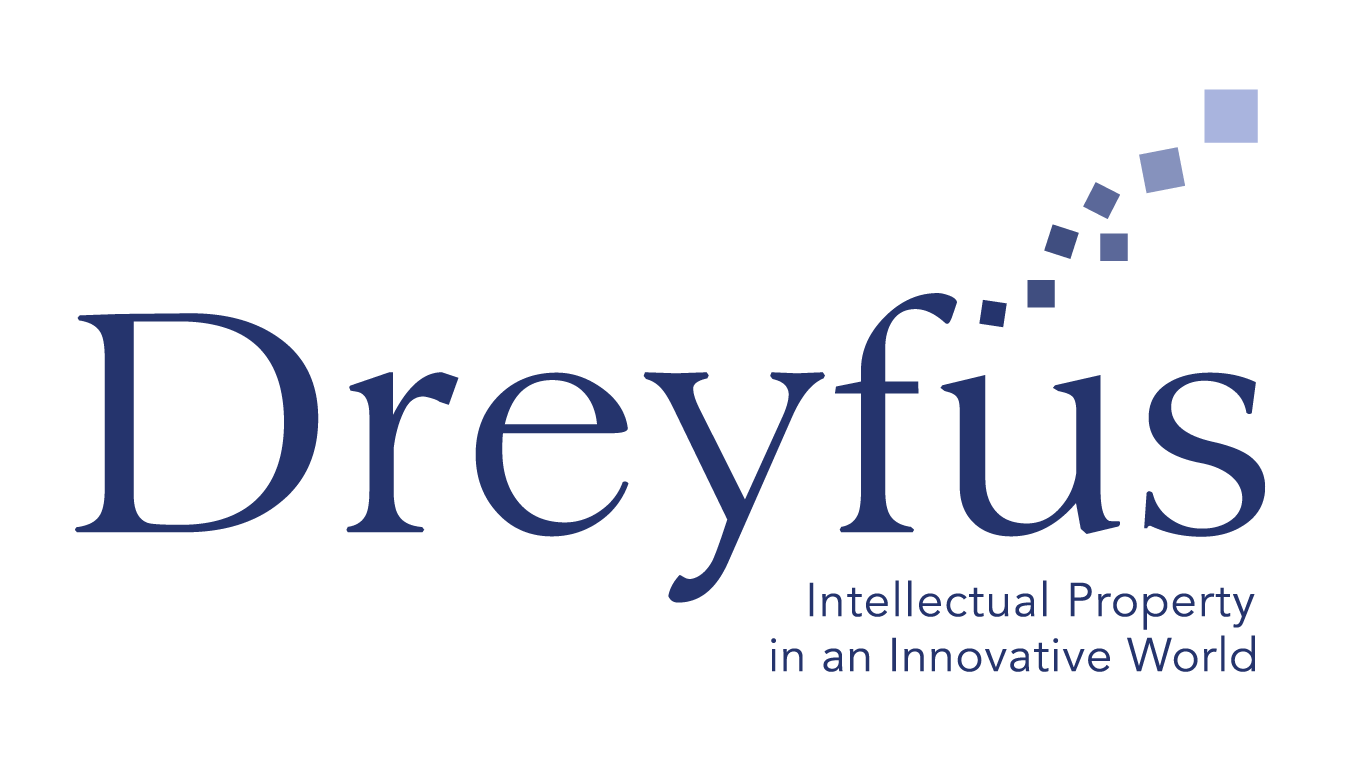
by LFWd5Wu4eq | Apr 24, 2024 | Uncategorized
Image Générée par DALL E 3ème version Microsoft
In an era where artificial intelligence (AI) and innovative technologies increasingly take a center stage, their legal protection becomes paramount. These innovations, born from substantial investments in research and development, can be secured and valorized through intellectual property mechanisms. This approach is vital for both individual creators and corporations, enabling them to not only protect their inventions but also to foster innovation and market competitiveness.
Fundamentals of Legal Protection for Technological Innovations
The protection of technological innovations is based on various intellectual property rights. Trademark law, copyright law, industrial property rights (including patents and designs), and digital rights law are all applicable depending on the nature of the innovation. For example, an innovative user interface may be protected by copyright, while a new AI data processing method could be patentable. Additionally, the GDPR imposes a strict framework for the handling of personal data, which is particularly relevant to AI applications.
Legal strategies for the valorization of AI
The first step in valuating innovative technologies such as AI is to secure the associated intellectual property (IP). This may include filing for patents, registering trademarks, protecting copyright, and establishing trade secrets to safeguard know-how and confidential information.
The transfer of innovative technologies is also central to the innovation process. It can take various forms, such as the transfer from public research to the private sector, partnership research, or transfer between private organizations. Each type of transfer has its own mechanisms, benefits, and drawbacks that must be carefully evaluated to optimize the innovation’s valuation (Engineer Techniques).
Effective valorization of innovative technologies also requires a clear strategy for their commercial exploitation. This might involve creating spin-off companies, licensing the technology to third parties, or integrating the innovations into the existing products and services of the company.
Finally, navigating the regulatory and legal framework is crucial for the valorization of innovative technologies. This includes compliance with local and international regulations, negotiating technology transfer contracts, and managing the legal risks associated with the use of new technologies.
Legal challenges specific to AI
In the field of AI, monitoring potential infringements of rights and protecting e-reputation become continuously important concerns. Proactive rights monitoring allows for identifying and acting against unauthorized uses, particularly on online platforms and social networks.
Also, the specificity of AI demands particular attention during the negotiation and drafting of license agreements and coexistence agreements. These documents must account for the peculiarities of AI technologies, especially in terms of use, data processing and data sharing, as well as liability.
Case studies illustrating how well-structured legal protection has enhanced AI innovations can be particularly enlightening. Whether through the defence of intellectual property rights, optimization of e-commerce strategies, or compliance with the GDPR, these concrete examples demonstrate the positive impact of an adapted legal approach on the success of AI projects.
Conclusion
Adopting a robust legal strategy is indispensable for the valuation and protection of technological innovations, particularly in the realm of artificial intelligence. This requires a deep understanding of intellectual property rights and an ability to anticipate the specific challenges posed by these advanced technologies. Creators and corporations are therefore encouraged to consult with intellectual property experts. Dreyfus offers personalized support to help you successfully navigate these complex legal waters.

by Marketing Team | Apr 11, 2024 | Uncategorized
Image generated by DALL E 3 Microsoft version
Navigating the intersection of cutting-edge technologies such as blockchain and artificial intelligence (AI) with established legal norms presents a complex challenge to regulatory bodies. While these innovations offer substantial improvements in terms of operational efficiency and security measures, they simultaneously introduce unique legal dilemmas. This article aims to explore the dynamics between these technological advancements and existing legislative frameworks, highlighting the necessary adaptations to ensure that intellectual property rights are adequately safeguarded in the digital age.
The Regulation of Artificial Intelligence: An Evolving Landscape
The legal framework governing Artificial Intelligence (AI) is in a state of flux, marked by the absence of cohesive legislation on one hand, and the development of new regulatory proposals on the other. This changing tide was notably underscored by the National Consultative Commission on Human Rights (CNCDH) in its April 7, 2022, opinion on the proposed regulation for AI, widely referred to as the AI Act. The proposed Act seeks to categorize AI applications based on their risk level, offering a blueprint that could guide global AI policy. This movement towards regulating AI mirrors the approach taken with the Markets in Crypto Assets (MiCA) Regulation for blockchain technology, aiming to protect the digital ecosystem while fostering responsible innovation.
Fundamental Prohibitions in Artificial Intelligence Use
The specific prohibitions on particular uses of AI, as outlined in the AI Act, underscore the European Union’s commitment to safeguarding fundamental human rights. By distinguishing between different AI applications based on their potential for harm, the Act navigates the fine line between fostering innovation and ensuring the protection of rights. Article 5 zeroes in on practices deemed high-risk and unacceptable, such as “dark patterns” that subtly manipulate behaviors or target vulnerable groups. This emphasizes the establishment of ethical boundaries to curb potential misuses of AI technology.
Enhanced Requirements for AI Providers and Users
This legislation outlines the duties of both providers and professionals who deploy high-risk AI systems, underlining the importance of rigorous safety, transparency, and data governance protocols. Specifically, Article 29 of the AI Act obligates professional users, or deployers, to verify that providers adhere to the required regulatory standards. It is imperative for all stakeholders engaged with high-risk AI to adopt suitable technical and organizational safeguards to align with regulatory expectations. This involves a meticulous approach to choosing and applying AI technologies, as well as fostering a collaborative relationship with providers to ensure compliance with prevailing norms.
As we conclude our exploration of the intricacies and regulatory responses to artificial intelligence, encapsulating both the promise and the challenges of AI technologies, we pivot towards another transformative domain. This transition guides us from the realm of AI, where ethical considerations and human rights are paramount, to the innovative landscape of blockchain technology. Here, we delve into how blockchain’s integration into the legal framework represents a parallel journey of adaptation and regulation, echoing the complexities and potential we’ve observed with AI.
Understanding Blockchain and Its Legal Framework
The integration of blockchain technology into the French legal landscape has steadily advanced, underscored by the enactment of Decree No. 2018-1226 in December 2018. This legislation highlights the technology’s capacity for creating a secure, immutable ledger, pivotal for data integrity and the traceability of financial transactions. Further legislative developments, notably the PACTE law of 2019, have laid down a legal framework for providers of digital asset services (PSAN), thereby recognizing the importance of crypto-assets within the digital economy. This recognition not only underscores the relevance of blockchain in modern regulatory contexts but also enhances the visibility of terms such as “blockchain legal framework,” “French blockchain integration,” and “digital asset regulation” in search engine optimization strategies.
Towards European Harmonization with the Markets in Crypto Assets Regulation
In an effort to create a cohesive regulatory framework across Europe, the European Council ratified the MiCA (Markets in Crypto-Assets) Regulation in April 2023, targeting the establishment of uniform standards for the issuance of crypto-assets and the operation of digital asset service providers (DASP). This regulation delineates clear responsibilities for entities in the crypto-market, including a stipulation that certain service providers, like those offering crypto-asset portfolio management and investment advisory services, must secure formal approval. These requirements are specified within the 5th section of Article L.54-10-2 in the Monetary and Financial Code.
Although MiCA provides a broad regulatory oversight, it notably does not apply to non-fungible tokens (NFTs) and some decentralized crypto services, such as utility tokens including Ether (ETH) and Binance Coin (BNB), which has sparked debate. Moreover, MiCA prioritizes consumer safety, introducing measures against money laundering and mandating that providers furnish clear and precise information about their products and services. With enforcement anticipated by the end of 2024, MiCA aims to safeguard and streamline digital financial activities, facilitating the adoption of innovative technologies and the alignment of consumer protection standards throughout the European Union.
Successfully Navigating the Digital Landscape
The convergence of blockchain technology and artificial intelligence (AI) represents an area of rapid evolution, brimming with potential yet fraught with complexities. Recent shifts in legislation and regulation seek to create a conducive environment for the responsible implementation of these advanced technologies, ensuring the protection of essential freedoms and the rights of intellectual property owners. In this dynamic and shifting terrain, businesses must prioritize strategic vision and continuous flexibility. Consulting with a knowledgeable partner such as Dreyfus.io becomes crucial for the protection and augmentation of intangible assets’ value, providing expert advice and brand defense across diverse industries.
Join us on social media !
LinkedIn
Instagram

by Marketing Team | Apr 4, 2024 | Uncategorized
Image Generated by DALL E 3 Microsoft Version
Integrating Artificial Intelligence (AI) into healthcare is an exciting frontier for innovation. According to an INSERM report, AI is set to transform various sectors such as predictive medicine, precision healthcare, support for decision-making, companion robots, computer-assisted surgery, and epidemic prevention. Nevertheless, deploying AI in healthcare introduces a multifaceted set of challenges that span human, economic, ethical, ecological, political, and legal dimensions.
Legal Framework for AI in Healthcare
In response to these challenges, the legal framework for AI in healthcare in France and the European Union is evolving to meet technical demands. France has taken steps such as establishing the Health Data Hub and simplifying access to national health data. Concurrently, the European Union has taken proactive steps like implementing the Data Governance Act to ease data reuse.
This AI ecosystem must navigate a complex mix of norms, including public health regulations, privacy laws, cybersecurity risks, and AI-specific regulations. Notably, the European AI Act, initiated by the European Commission and adopted in February 2024, sets out to standardize the application of AI by introducing overarching rules, legal definitions, and penalties for non-compliance.
However, this changing legal landscape brings its own set of challenges. Striving to protect privacy rights has led to a regulatory proliferation that could complicate the field, particularly against a backdrop of global competition with regions having fewer regulations. This complexity highlights the critical need to strike a balance between fostering innovation and research and protecting fundamental rights and privacy.
Governance of AI in Healthcare
The foundation of AI’s reliability in healthcare is its dependence on high-quality data, underscored by the GDPR’s strict privacy guidelines. The AI Act bolsters these efforts by mandating a “quality management system” for AI, ensuring transparency from development to deployment. This focus on data integrity is essential for establishing trust in AI applications within healthcare.
AI systems are categorized by the level of risk they present, from unacceptable to minimal. High-risk scenarios, especially those impacting healthcare delivery and patient outcomes, necessitate thorough evaluation and adherence to the utmost safety and ethical standards. The AI Act outlines this evaluation process, advocating for a balanced approach to risk and benefits and stringent certification for high-risk AI systems.
Compliance with the AI Act is therefore built on four pillars:
- Ensuring the reliability of AI through quality training data and bias management;
- Maintaining confidentiality and data protection;
- Explicability of AI systems to users; and
- Robust monitoring mechanisms throughout the AI’s lifecycle.
These pillars ensure AI systems are not only technologically advanced but also ethically responsible and legally compliant.
Legal Roadmap for AI Deployment
As the healthcare sector increasingly integrates Artificial Intelligence (AI), both the creators and implementers of these technologies encounter a challenging legal landscape. Navigating the deployment of AI requires meticulous attention, especially as the regulatory framework continues to evolve.
For developers, this journey involves addressing a wide array of compliance challenges. They must ensure the legality of their training data and address any potential biases, while also adhering to EU regulatory standards and ensuring the technical resilience of their solutions. This process demands a thorough examination of data processing practices, the ethical implications of AI applications, and the strength of cybersecurity defenses. Additionally, maintaining transparency regarding contractual obligations and clearly communicating the capabilities and limitations of AI solutions is paramount.
On the other hand, healthcare entities looking to implement AI, such as hospitals exploring AI for diagnostic tools, face their own set of challenges. They need to critically evaluate the AI technologies for biases, particularly those that might affect minority representation, and carry out extensive impact analyses to understand the potential effects on patient care. This assessment process also includes the establishment of a contractual governance framework to ensure that the functionality of the AI is comprehensively documented, and all associated liabilities are clearly outlined. As healthcare increasingly embraces AI, both developers and deployers face a complex legal terrain. The roadmap for AI deployment, still taking shape under evolving regulations, demands careful navigation.
Conclusion
The deployment of AI in healthcare navigates a delicate balance between the potential for innovation and a myriad of ethical, legal, and practical challenges. As AI evolves, developers and deployers must operate within this regulatory framework to ensure their solutions are innovative, equitable, secure, and transparent. This approach will foster trust and effectiveness in healthcare applications.
At Dreyfus, we are here to support you in launching your AI projects in line with the intricate web of current and forthcoming regulations. Feel free to reach out for assistance!



